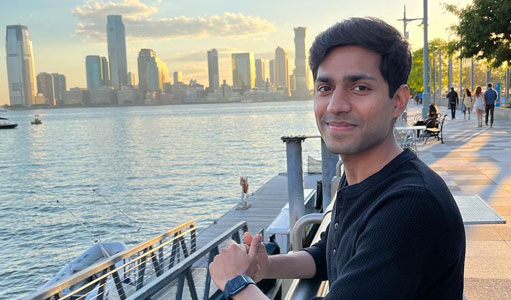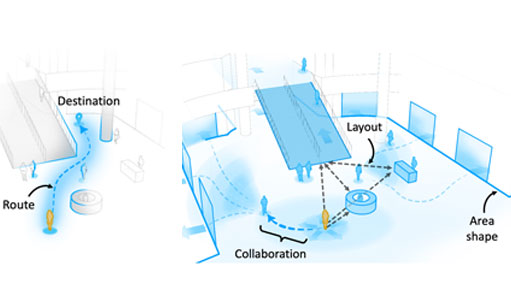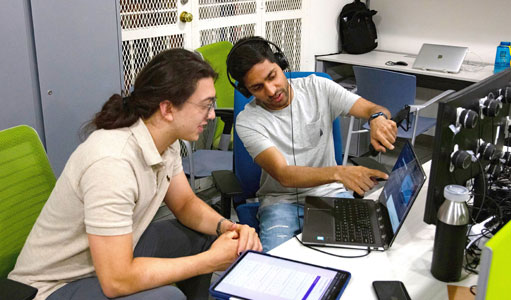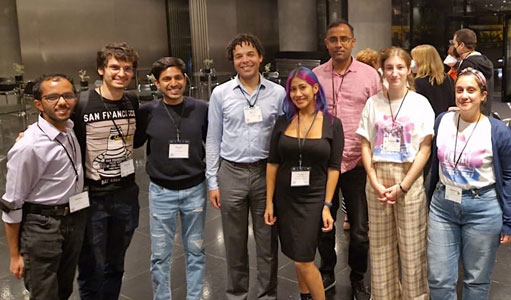Voices of CS: Gaurav Jain
The third-year PhD student is creating tools to help people with vision impairments navigate the world.
Imagine walking to your office from the subway station on a Monday morning. You notice a new café on the way, so you decide to take a detour and try a latté. That sounds like a normal way to start the week, right?
But for people with vision impairment or low vision, like those who are categorized as blind and low vision (BLV), this kind of spontaneous exploration while outside is challenging. Current navigation assistance systems (NAS) provide turn-by-turn instructions, but they do not allow visually impaired users to deviate from the shortest path to their destination or make decisions on the fly. As a result, people with vision impairment or low vision often miss out on the freedom to go out and navigate on their own terms.

In a paper published at the ACM Conference On Computer-Supported Cooperative Work And Social Computing (CSCW ‘23), computer science researchers introduced the concept of “Exploration Assistance,” which is an evolution of current NASs that can support BLV people’s exploration in unfamiliar environments. Led by Gaurav Jain, the researchers investigated how NASs should be designed by interviewing BLV people, orientation and mobility instructors, and leaders of blind-serving organizations, to understand their specific needs and challenges. Their findings highlight the types of spatial information required for exploration beyond turn-by-turn instructions and the difficulties faced by BLV people when exploring alone or with the help of others.
Jain, who is advised by Assistant Professor Brian Smith, is a PhD student in the Computer-Enabled Abilities Laboratory (CEAL Lab), where researchers develop computers that help people perceive and interact with the world around them. Their paper presents the results of interviews with BLV people and other stakeholders to identify the types of spatial information BLV people need for exploration and the challenges BLV people face when exploring unfamiliar environments. The paper offers insights into the design and development of new navigation assistance systems that can support BLV people in exploring unfamiliar environments with greater spontaneity and agency.

Based on their findings, they presented several instances of NASs that support the exploration assistance paradigm and identify several challenges that need to be overcome to make these systems a reality. Jain hopes that his research will ultimately enable BLV people to experience greater agency and independence as they navigate and explore their environments. We sat down with Jain to learn more about his research, doing qualitative research, and the thought processes behind writing research papers.
Q: What is exploration assistance and why is it important to do research on it?
This research is incredibly exciting for the blind and low vision (BLV) community, as it represents a significant step towards equal access and agency in exploring unfamiliar environments. For BLV people, the ability to navigate and explore independently is essential to daily life, and current navigation assistance systems often limit their ability to do so. By introducing the concept of exploration assistance, this research opens up new possibilities for BLV people to explore and discover their surroundings with greater spontaneity and freedom. This research has the potential to significantly improve the quality of life for BLV people and is a major development in the ongoing pursuit of accessibility and inclusion for all.
Q: How did you become part of the research project?
This was my first project as a PhD student in the CEAL lab. The project was initiated as a camera-based wearable NAS for BLV people, and we conducted several formative studies with BLV people.
As we progressed, we realized that there was a significant research gap in the research community’s understanding of how NASs could support BLV people’s exploration in navigation. Based on these findings, we shifted our focus toward investigating this gap, and the paper I worked on was the result of this pivot. The paper is titled, “I Want to Figure Things Out”: Supporting Exploration in Navigation for People with Visual Impairments.
Q: The research was more qualitative, right? How did you find working on it?
Over the course of approximately one year, I had the opportunity to work on this project that challenged me to step outside of my comfort zone as a human-computer interaction (HCI) researcher. Before this project, my research experience had primarily focused on computer vision and deep learning. I was more at ease with HCI systems research, which involved designing, building, and evaluating tools and techniques to solve user problems.
This project, however, was a qualitative research study that aimed to gain a deeper understanding of user needs, behaviors, challenges, and attitudes toward technology through in-depth interviews, observations, and other qualitative data collection methods. To prepare for this project, I had to immerse myself in the field of accessibility and navigation assistance for BLV people and read extensively on papers that employed qualitative research methods.
Although it took some time for me to shift my mindset towards qualitative research, this project helped me become a more well-rounded researcher, as I now feel comfortable with both qualitative and systems research. Overall, this project was a significant personal and professional growth experience, as I was able to expand my research expertise and contribute to a worthy cause.
Q: Can you talk about the process of writing the paper? When it came time to start writing, how did you organize your thoughts and the data?
Writing the paper was a critical stage in the research process, and I approached it by first organizing my thoughts and drafting a clear outline. I started by creating an outline of the paper with section and subsection headers, accompanied by a brief summary of what I intended to discuss in each section. This process allowed me to see the overall structure of the paper and ensure that I covered all the essential elements.
Once I had a clear structure in mind, I began to tackle each section of the paper one by one, starting with the introduction and then moving on to the methods, results, and discussion sections. I iteratively refined my writing based on feedback from my advisor, lab mates, and friends.
Throughout the writing process, I also ensured that my writing was clear, concise, and easy to follow. I paid close attention to the flow of ideas and transitions between sections, making sure that each paragraph and sentence contributed to the overall argument and was well-supported by the evidence.
Overall, the process of writing the paper was challenging but rewarding. It allowed me to synthesize the research findings and present them in a compelling way, showcasing the impact of our work on the lives of BLV people.
Q: What did you find surprising or challenging about the process?
Throughout the research process, I encountered various challenges that both surprised and tested me. Interviewing participants, in particular, proved to be an intriguing yet difficult task. Initially, I struggled to guide conversations naturally toward my research questions without leading participants toward a certain answer. However, with each interview, I became more confident and began to enjoy the process. Hearing firsthand from BLV people that our work could make a real impact on their lives was also incredibly rewarding.
Analyzing and synthesizing the interview data was another major challenge. Unlike quantitative data, conversations are often open-ended and context-dependent, making it difficult to separate my own biases from the interviewee’s responses. I spent a considerable amount of time reviewing the interview transcripts and identifying emerging themes. To facilitate this process, I leveraged tools like NVivo to better organize the interview data, and our team held several discussions to refine these themes. To ensure the accuracy of our interpretation, we sought feedback from two BLV interns who worked with us over the summer on another project.
Overall, this research experience pushed me to become more adaptable. While it presented its own unique set of challenges, I am proud to have contributed to a project that has the potential to create meaningful change in the lives of BLV people.

Q: Did it change your view on how you should do research?
Yes, my experience with this research project has certainly changed my view on how to approach research. It has taught me the importance of keeping the paper in mind from the beginning of a project.
Now, I make a conscious effort to think about how I want to present my work and what story I want to tell with the research. This helps me gain more clarity on the direction of the project and how to steer it toward producing meaningful results. As part of my workflow, I now write early drafts of paper introductions even before developing any tools or systems. This allows me to zoom out from the day-to-day technical challenges and see the big picture, which is crucial in making sure that the research is both impactful and well-presented.
Q: What are your tips for writing a research paper?
Writing a research paper can be a challenging task, but here are a few tips that have helped me make the process smoother:
- Start with a rough draft: Don’t expect your first draft to be perfect. It’s important to just start writing and get your ideas on paper. You can always revise and edit later. Use a tool like Microsoft Word or Google Docs to get started instead of working directly with Overleaf. I found this to take the pressure off me.
- Observe your advisor’s edits: Your advisor can be a valuable resource when it comes to writing. Observing your advisor edit your drafts can help you learn from their feedback. I usually ask my advisor, Brian Smith, to describe why he made a certain edit and that helps me understand his process and also identify specific issues where I need to work more on.
- Get feedback and revise: It’s important to get feedback on your paper from others. Share your draft with colleagues, friends, and family, and ask for their honest feedback. Use their feedback to revise and improve your paper. Whenever I’m writing, I socialize my writing with others, including my advisor, my lab mates, my friends, and my family. Interestingly, I get the most useful feedback from my friends and family, who have no idea what my research is about. I ask them to describe what they understood from the text I shared and try to match their description with my intended purpose. Writing is an iterative process; it takes several drafts before you have a polished paper.
Finally, one resource that I would totally recommend to every PhD student at Columbia is Adjunct Professor Janet Kayfetz’s class on Technical Writing. Her class is an excellent way to deeply understand research writing.
Q: What are you working on now?
I am currently working on two exciting projects that further my research goal of developing inclusive physical and digital environments for BLV people. The first project involves enhancing the capabilities of smart streets, streets with sensors like cameras and computing power, to help BLV people navigate street intersections safely.
This project is part of the NSF Engineering Research Center for Smart Streetscapes’ application thrust. The second project is focused on making videos accessible to BLV people by creating high-quality audio descriptions available at scale.
Q: Can you talk about your background and why you decided to pursue a PhD?
My exposure to research during my undergrad was invaluable, as it allowed me to work on diverse projects utilizing computer vision for various applications such as biometric security and medical imaging. These experiences instilled in me a passion for the research process. It was fulfilling to be able to identify problems that I care about, explore solutions, and disseminate new knowledge.
While I knew I enjoyed research, it was during the summer research fellowship at the Indian Institute of Sciences, where I collaborated with Professor P. K. Yalavarthy in the Medical Imaging Group, that crystallized my decision to pursue a PhD. The opportunity to work in a research lab, lead a project, and receive mentorship from an experienced advisor provided a glimpse of what a PhD program entails. I was excited by the prospect of being able to make a real-world impact by solving complex problems, and it was then that I decided to pursue a career in research.
Q: How has your research interest changed since you started your PhD?
I am interested in building Human-AI systems that embed AI technologies (e.g., computer vision) into human interactions to help BLV people better experience the world around them. My work on exploration assistance informs the design of future navigation assistance systems that enable BLV people to experience the physical world with more agency and spontaneity during navigation.
In addition to the physical world, I’ve also broadened my research focus to enhance BLV people’s experiences within the digital world. For example, I developed a system that makes it possible for BLV people to visualize the action in sports broadcasts rather than relying on other people’s descriptions of the game.
Q: What sort of research questions do you hope to answer now?
Accessibility research has traditionally focused on aiding daily-life activities and providing access to digital information for productivity and work, but there’s an increasing realization that providing access to everyday cultural experiences is equally important for inclusion and well-being.
This encompasses various forms of entertainment and recreation, such as watching TV, exploring museums, playing video games, listening to music, and engaging with social media. Ensuring that everyone has equal opportunities to enjoy these experiences is an emerging challenge. My goal is to design human-AI systems that enhance such experiences.
Q: Why did you choose to apply to Columbia CS? What attracted you to the program?
I was drawn to Columbia CS because of the type of problems my advisor works on. His research focused on creating systems that have a direct impact on people’s lives, where evaluating the user’s experience with the system is a key component.
This was a departure from my undergraduate research, where I focused on building systems to achieve high accuracy and efficiency. I found this user-centered approach to be extremely exciting, especially in the context of his project “RAD,” which aimed to make video games accessible to blind gamers. It was a super exciting prospect to be working on similar problems where you can firsthand see how people reacted and benefited from your solutions. This still remains one of the most fulfilling aspects of HCI research for me. In the end, this is what led me to choose Columbia and work with Brian Smith.

Q: What has been the highlight of your time at Columbia?
The first thing that comes to mind is the people that I have had the pleasure of working with and meeting. I am grateful for the opportunity to learn from my advisor and appreciate the incredible atmosphere he has created for me to thrive.
Additionally, I have been fortunate enough to make some amazing friends here at Columbia who have become a vital support system. Balancing work with passions outside of work has also been important to me, and I am grateful for the chance to engage with student clubs such as the dance team, Columbia Bhangra, and meet some amazing people there as well. Overall, the community at Columbia has been a highlight for me.
Q: What is your advice to students on how to navigate their time at Columbia? If they want to do research, what should they know or do to prepare?
One thing that students wanting to do research should know is that research involves a lot of uncertainty and ambiguity. In fact, dealing with uncertainty can be one of the most challenging aspects of research, even more so than learning the technical skills required to complete a project.
In my own experience, staying motivated about the problem statement has been key to powering through those uncertain moments. Therefore, it is important to be true to yourself about what you are really excited about and work on those problems. Ultimately, this approach can go a long way in helping you navigate your time at Columbia and make the most of your research opportunities.

